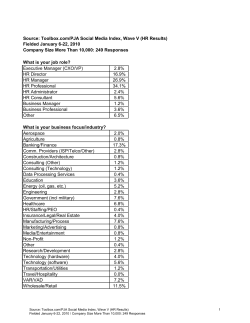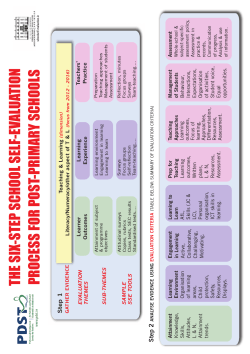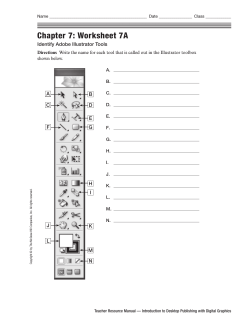
California Afterschool Outcome Measures Project
Capturing positive outcomes for youth in diverse Out-of-School Time Programs Why the Online Toolbox? Measures program quality and student outcomes Research-based scales with well-established reliability and validity Easy to administer online surveys Choose respondents: Students, Program Staff, and/or Classroom Teachers Program reports of site and program level data Online support for understanding program reports afterschooloutcomes.org Research Background of Measures Youth self-reports assess program environmental features shown to enhance youth outcomes: o Experience with program activities o Supportive relations with staff and peers These student reports of program experience correlate highly with observational data of program quality as assessed by the Promising Practices Ratings System (PPRS; Rosenthal & Vandell, 1996). Youth reports of program quality are linked to positive youth outcomes (Kataoka & Vandell, 2013). afterschooloutcomes.org Research Background of Measures The measures address 21st Century non-cognitive competencies identified by the National Research Council: o Personal and Social-Emotional Skills o Social Competencies o Academic Efficacy and Work Habits Research links socio-emotional development to academic gains (Durlak, Weissberg & Pachan, 2010). afterschooloutcomes.org Online Toolbox Surveys Three web-based surveys: 1. Student self-report (grades 3-12) 2. Program staff reports of student skills and behavior 3. Classroom teacher reports of student skills and behavior and academic outcomes for students in their class who attend the afterschool program afterschooloutcomes.org DESCRIPTION OF MEASURES STUDENT SELF-REPORT PROGRAM STAFF REPORTS & CLASSROOM TEACHER REPORTS Skill Development Work Habits Students’ Skill Development Reading Efficacy Work Habits Math Efficacy Task Persistence Science Efficacy Academic Performance Positive Behavior Change Students Behaviors (classroom teachers only) Social Competencies Aggressive Behavior with Peers Misconduct Prosocial Behavior with Peers Social Skills Program Quality Relationships with Staff Interest in Program Activities Relationships with Peers Also available STEM-related measures of Student’s Attitudes and Beliefs Science Interest Science Career View of Future afterschooloutcomes.org Student Survey Self-Report Measures of Skill Development # Items Sample Item 4-point Rating Response Work Habits 6 I finish my work on time. 1 = Not at all true; 4 = Really true Reading Efficacy 4 I expect to do well in reading. 1 = Not at all true; 4 = Really true Math Efficacy 4 I am interested in math. 1 = Not at all true; 4 = Really true Science Efficacy 4 I am interested in science. 1 = Not at all true; 4 = Really true afterschooloutcomes.org Student Survey Self-Report Measures of Behavior # Items Sample Item 4-point Rating Response Social Competencies 7 I work well with other kids. 1 = Poor; 4 = Excellent Misconduct 9 I have gotten into a fight at school. 0 = Never; 3 = More than once a week afterschooloutcomes.org Student Survey Self-Report Measures of Attitudes and Beliefs, Student Self-Report # Items Sample Item 4-point Rating Response Science Interest 24 I get excited about learning new discoveries or inventions. 1 = Not at all true; 4 = Really true Science Career 12 I will get a job in a sciencerelated area. 1 = Not at all true; 4 = Really true View of Future 7 I will go to college. 1 = Not at all true; 4 = Really true afterschooloutcomes.org Student Survey Self-Report Measures of Quality of Program Experience # Items Sample Item 4-point Rating Response Relationships with Staff 6 I trust the teachers here. 1 = Not at all true; 4 = Really true Relationships with Peers 5 I get to know other kids really well here. 1 = Not at all true; 4 = Really true Program Activities 5 I like the activities here. 1 = Not at all true; 4 = Really true afterschooloutcomes.org The Promising Practices Ratings System* The PPRS is an observational tool that assesses eight aspects of program quality: Supportive relations with adults Opportunities for cognitive growth Supportive relations with peers Student engagement in activities Setting chaos Mastery orientation Staff overcontrol * Vandell et al. (March, 2005) Appropriate program structure The Promising Practices Ratings System The PPRS eight program processes have been linked to positive social and academic outcomes for children and adolescents. * The PPRS can be used to supplement the Online Toolbox student outcome data with observational data of program quality, or it can be used by itself. *(Eccles & Gootman, 2002; Pierce et al., 1999; Vandell, Shumow, & Posner, 2005) afterschooloutcomes.org Implementation of Online Toolbox Online Toolbox Implementation Available for use by all Out-of-School Time programs nationally Used statewide by afterschool and summer learning programs in California since 2013 Pilot implementation by 21st CCLC funded programs in Utah during 2014-15 California Statewide Implementation Funded by the California Department of Education After School Division Free-of-Cost Opportunity for California ASES and 21st CLCC Programs Over 1,000 sites selected to participate in 2013-14 Up to 2,000 sites can participate in 2014-15 afterschooloutcomes.org California Statewide Implementation Funded by the California Department of Education After School Division Benefits of Participation: Programs receive a report summarizing student outcome scores and student reports of quality of program experience. The report includes a summary of student scores for each participating program site in addition to the aggregate scores for their program. Programs can compare scores over time and their program aggregate score with the statewide results. Results can be used to inform internal program quality improvement and to report program outcomes to funders and other stakeholders. afterschooloutcomes.org How does it work? GO TO WEBSITE afterschooloutcomes.org COMPLETE ONLINE INTEREST FORM STEP-BY-STEP INSTRUCTIONS & LINKS TO SURVEYS Steps to Participate Complete Interest Form 1. • If not California ASES or 21stCCLC program contact afterschool@uci.edu 2. Complete Site List Template and Submit 3. Receive notification by email of selected programs and sites 4. Complete Participant Data Template and Submit 5. Receive Survey Codes to access surveys through Secure Program Portal Page Download Instructions on Administering Surveys 6. Administer Surveys 7. Program Portal Page: Use to retrieve survey codes, see tallies of surveys collected at your program sites, change password, add new participants http://afterschooloutcomes.org/ases-surveys INSTRUCTIONAL VIDEOS Click on Appropriate Link for Instructional Videos AOMOT TEAM a f t e r s c h o o l @ u c i .e d u 949-824-9225
© Copyright 2025












